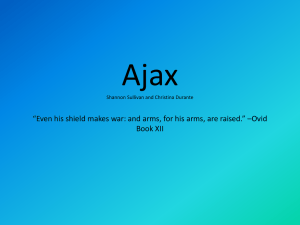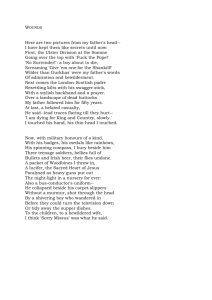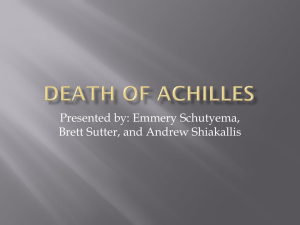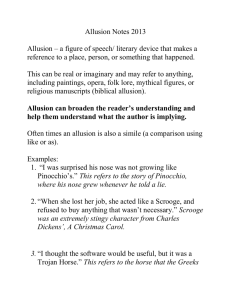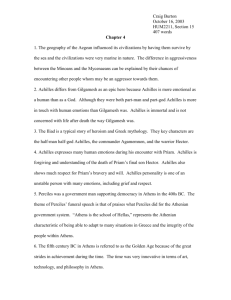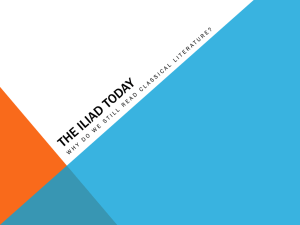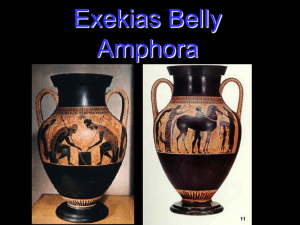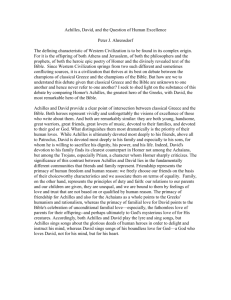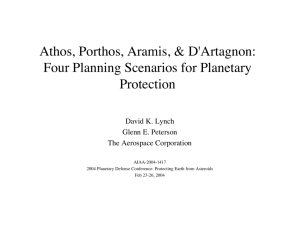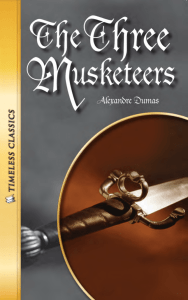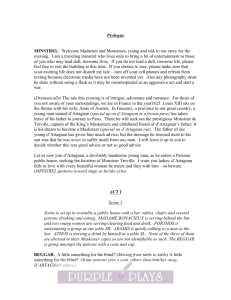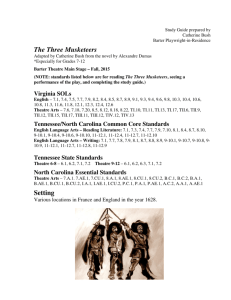Allusion Notebook - Jessamine County Schools
advertisement
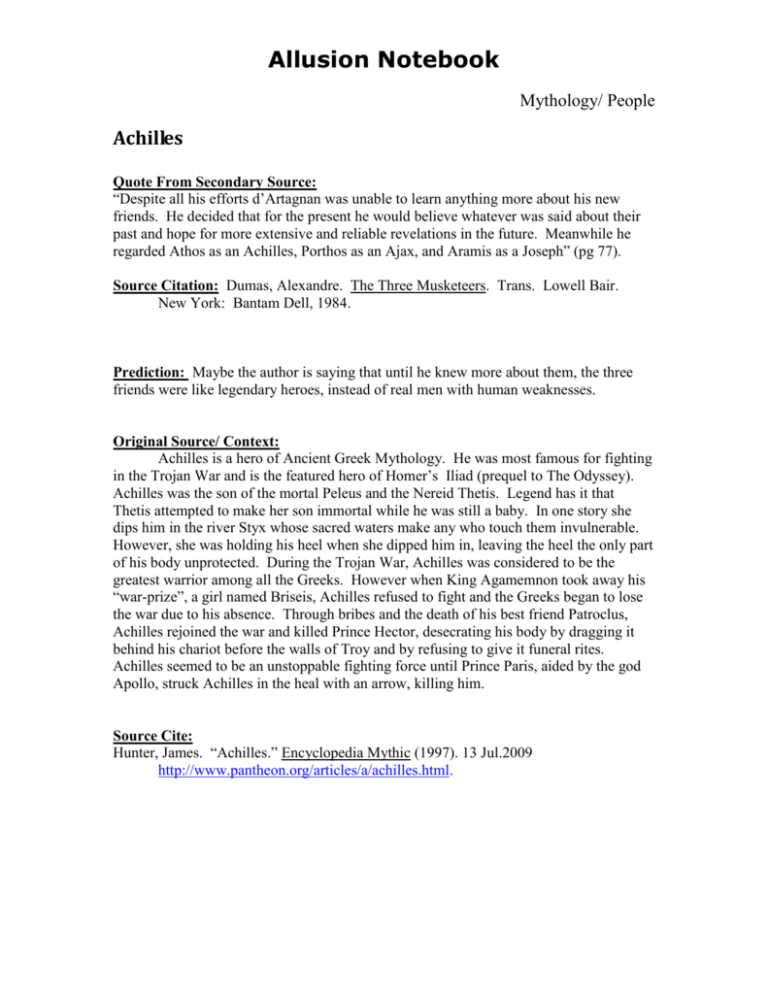
Allusion Notebook Mythology/ People Achilles Quote From Secondary Source: “Despite all his efforts d’Artagnan was unable to learn anything more about his new friends. He decided that for the present he would believe whatever was said about their past and hope for more extensive and reliable revelations in the future. Meanwhile he regarded Athos as an Achilles, Porthos as an Ajax, and Aramis as a Joseph” (pg 77). Source Citation: Dumas, Alexandre. The Three Musketeers. Trans. Lowell Bair. New York: Bantam Dell, 1984. Prediction: Maybe the author is saying that until he knew more about them, the three friends were like legendary heroes, instead of real men with human weaknesses. Original Source/ Context: Achilles is a hero of Ancient Greek Mythology. He was most famous for fighting in the Trojan War and is the featured hero of Homer’s Iliad (prequel to The Odyssey). Achilles was the son of the mortal Peleus and the Nereid Thetis. Legend has it that Thetis attempted to make her son immortal while he was still a baby. In one story she dips him in the river Styx whose sacred waters make any who touch them invulnerable. However, she was holding his heel when she dipped him in, leaving the heel the only part of his body unprotected. During the Trojan War, Achilles was considered to be the greatest warrior among all the Greeks. However when King Agamemnon took away his “war-prize”, a girl named Briseis, Achilles refused to fight and the Greeks began to lose the war due to his absence. Through bribes and the death of his best friend Patroclus, Achilles rejoined the war and killed Prince Hector, desecrating his body by dragging it behind his chariot before the walls of Troy and by refusing to give it funeral rites. Achilles seemed to be an unstoppable fighting force until Prince Paris, aided by the god Apollo, struck Achilles in the heal with an arrow, killing him. Source Cite: Hunter, James. “Achilles.” Encyclopedia Mythic (1997). 13 Jul.2009 http://www.pantheon.org/articles/a/achilles.html. Allusion Notebook Effect/Insight: Athos seems to a larger than life hero to d’Artagnan. Achilles had a Nereid for a mother and Athos too seems to have come from nobility, something d’Artagnan admires greatly having come for a poor and uncultured family. He sees Athos as the best warrior of all the Musketeers much as Achilles was the best among the Greek fighting force. He seems to be virtually unstoppable when it comes to fighting and indestructible just as Achilles was. He also seems to be fearless, he is not afraid to die and that courage means that he shows no pity toward his enemies even if they happen to be beautiful women or powerful statesmen. Achilles in the same way, took no pity on Hector’s body and even King Priam knelt before him in humility of defeat. Athos is also highly revered by his superiors (Monsieur Treville and the Cardinal). It is yet to be known what Athos’ weakness is at this point in the book, but after finishing the book, one discovers that his “Achilles’ heel” is his long-lost wife Anne de Bruil whom he failed to kill when he first discovered her criminal past and evil nature. Her presence threatens the life of his dear friend d’Artagnan, the interests of the queen who he is devouted to, and his very life. This allusion also sheds light on how d’Artagnan views Athos in this stage of the book. He can see no faults in his idol and as a man who one day hopes to be a Musketeer himself, he looks to Athos’ example for how to be the best warrior one can be. He has not yet discovered any of the dark things in Athos’ past. His lack of knowledge keeps him from becoming a friend on equal ground with Athos. Only when he learns more about Athos’ past and his weaknesses will d’Artagnan see Athos as a man instead of a legend. Allusion Notebook Mythology/ People Ajax Quote From Secondary Source: “Despite all his efforts d’Artagnan was unable to learn anything more about his new friends. He decided that for the present he would believe whatever was said about their past and hope for more extensive and reliable revelations in the future. Meanwhile he regarded Athos as an Achilles, Porthos as an Ajax, and Aramis as a Joseph” (pg 77). Source Citation: Dumas, Alexandre. The Three Musketeers. Trans. Lowell Bair. New York: Bantam Dell, 1984. Prediction: Maybe the author is saying that until he knew more about them, the three friends were like legendary heroes, instead of real men with human weaknesses. Original Source/ Context: There are two “Ajax” heroes mentioned in Greek Mythology. Both fought in the Trojan War. The first Ajax was the second best warrior after Achilles. He was known as “the wall” because of his huge size which made up for his slow speech. He proved his bravery by meeting Hector alone in battle during the time when Achilles had withdrawn from the war. The two fought and the duel ended in a stalemate though Ajax escaped with no wounds while injuring Hector. Finally this first Ajax is known for competing against Odysseus for the beautiful suit of Armor left by the dead Achilles. The two both gave speeches but Odysseus, being the more witty and eloquent of the two, on the armor. Ajax was so disappointed about the armor that he went crazy, killing cattle he thought were Trojans , and finally killing himself; all over a suit of armor. The second Ajax is known as “Ajax the lesser”. He also fought at Troy and was known for being arrogant, boastful, and quarrelsome. After raping King Priam’s daughter Cassandra, he was thrown out of the Greek army. On his return trip home, his ship was sunk in a storm. Later he boasted so loudly about his escape that Poseidon, god of the sea, threw him back into the ocean where he drowned. Source Cite: Hunter, James. “Ajax.” Encyclopedia Mythic (1997). 13 Jul.2009 http://www.pantheon.org/articles/a/ajax.html. Hunter, James. “Ajax.” Encyclopedia Mythic (1997). 13 Jul.2009 http://www.pantheon.org/articles/a/ajax.html. Allusion Notebook Effect/Insight: Porthos has something in common with both the “greater” and “lesser” Ajax. Porthos is a brave fighter, though perhaps not as revered as Athos (much as Ajax was not as famous as Achilles). However, many of his troubles surface with his tendency to put too much stock in looking and sounding grand in the eyes of others. Ajax valued Achilles armor so much that he went crazy when he couldn’t have it and chose death over a life without it. In the same way, Porthos desires to have the very best clothes and would rather be dead than to appear poor or unfashionable. His love of flashy clothing is seen in d’Artagnan’s first encounter with Porthos. The musketeer is wearing a belt for his sword that appears to be covered entirely with gold though half of it is covered in a long cloak. When d’Artagnan bumps into Porthos he sees that the belt is only half covered in gold and he realizes that Porthos was trying to cover up the ordinary half with his cloak to give the illusion that he was very rich. Porthos also has much in common with Ajax “the lesser”. Porthos speaks very loudly so that all can hear him. He brags about his wealth and his affairs with very rich and powerful women. These boasts get him into trouble when d’Artagnan reveals that he knows the truth about his belt (which leads to a duel between the two) and when it is revealed that his only affair is with an old woman whose husband is a stingy lawyer and unwilling to finance Porthos’ expensive lifestyle. D’Artagnan sees Porthos’ preoccupation with outward appearance and his tendency to boast from their very first meeting and connects his new friend with that legendary hero with the same character flaws. Allusion Notebook Notebook Organization: -Entries should be kept in a three ring (paper fastener variety) folder -Entries should be organized under the following 5 dividers: -History (people, places, events) -Literature -Bible -Mythology (myth of any origin may be included) -The Arts (music, art, dance, and popular culture) -Each entry should include: *Credible research to show the original source material for each reference. *MLA citation of sources *Objective and comprehensive summary of research. *A written analysis that shows how the allusion impacts the meaning of the text in which it is found. YOU MUST HAVE 10 ENTRIES TOTAL. *You need to turn in one allusion entry for NTI Day 10 *Whether we have NTI days or not, you must have turned in 5 entries for formative assessment/teacher feedback by March 26th (before) Spring Break. *All finalized 10 entries are due on the first day of the last week of school. Allusion Notebook Scoring Rubric (Please put this in the front of your completed notebook!) Targets 4 3 2 1 (9-10.W.8) Gather relevant information from multiple authoritative print and digital sources, using advanced searches effectively; assess the usefulness of each source in answering the research question; integrate information into the text selectively to maintain the flow of ideas, avoiding plagiarism and following a standard format for citation. (9-10.W.7) Conduct short as well as more sustained research projects; narrow or broaden the inquiry when appropriate; synthesize multiple sources on the subject, demonstrating understanding of the subject under investigation. Student identifies multiple, sufficient and appropriate and credible digital and/or print sources and correctly cites sources. 1 error in citation or in appropriatene ss of research. 2 or more errors in citation of research with insufficient research. Some errors may exist in appropriatene ss of sources. No credible citation of sources exists to accompany research. Student’s research is present and thorough as well as accurate, showing understanding of the allusion. Student’s research shows great gaps in understanding with many errors. Student’s “research” shows no outside inquiry or is completely inaccurate. Target 60 (9-10.RL.9): I can identify examples of allusion. The allusion is accurately identified. Student’s research is present and accurate, showing understanding of the allusion. It is not, however, of sufficient length. N/A N/A Target 62(9-10.RL.9): I can analyze how an author utilizes source material in their writing to create meaning. Student accurately, insightfully, and thoroughly analyzes how an author uses source material (research) to create meaning in the identified text. Student analyzes how an author uses source material (research) to create meaning with 1 or 2 errors. Student’s analysis has some accurate elements but several errors exist or the analysis is not complete. The allusion is not accurately identified. Student’s analysis is completely inaccurate or is overgenerali zed.
